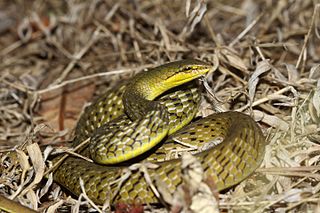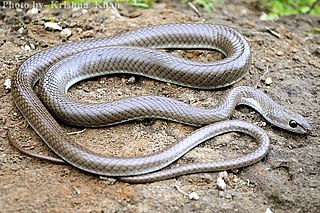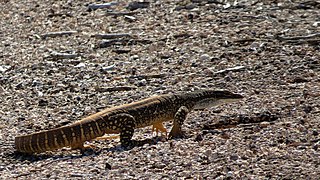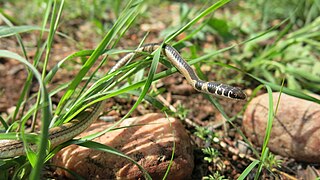
Cerastes cerastes, commonly known as the Saharan horned viper or the desert horned viper, is a venomous species of viper native to the deserts of northern Africa and parts of the Arabian Peninsula and Levant. It often is easily recognized by the presence of a pair of supraocular "horns", although hornless individuals do occur. Three subspecies have been described.

Ahaetulla perroteti, known commonly as the bronze-headed vine snake, Perrotet's vine snake, or the Western Ghats bronzeback, is a species of mildly venomous, rear-fanged snake in the family Colubridae. The species is endemic to the Western Ghats in South India.

The Schokari sand racer is a species of psammophiid snake found in parts of Asia and Africa. Psammophis schokari aegyptius has been elevated to species status. Many people refer to snakes in the genus Psammophis as colubrids, but this is now known to be incorrect—they were once classified in the Colubridae, but our more sophisticated understanding of the relationships among the groups of snakes has led herpetologists to reclassify Psammophis and its relatives into Lamprophiidae, a family more closely related to Elapidae than to Colubridae.
Psammophis leithii, commonly called the Pakistan sand racer, Pakistani ribbon snake, or Leith's sand snake, is a species of rear-fanged snake in the family Psammophiidae. The species is native to South Asia. It is harmless to humans.

Psammophis condanarus, the sand snake, is a species of snake found in dry low country zones of Indian peninsula, Pakistan and Nepal. It is a fast-moving, diurnal, terrestrial species and lives in stony outcrops and boulders. It was first described from Ganjam area of Odisha State and then later on recorded from many parts of the Indian subcontinent.

Psammophis longifrons, the stout sand snake or long sand racer, is a species of snake found in India. It can grow to a maximum length of 57 inches.

The sand goanna is a species of large Australian monitor lizard, also known as Gould's monitor, sand monitor, or racehorse goanna.

Psammophis is a genus of snakes in the family Psammophiidae. The genus comprises 33 species, which are found in Africa and Asia. Psammophis are diurnal and prey on lizards and rodents which they actively hunt. All species in the genus are venomous, and the venom is considered mild and not dangerous to humans.

Eryx colubrinus, the Egyptian or Kenyan sand boa, is a species of snake in the family Boidae. The species is endemic to Northern and Eastern Africa. There are two subspecies which are recognized as being valid.

The yellow-faced whip snake is a species of venomous snake in the family Elapidae, a family containing many dangerous snakes. D. psammophis is endemic to Australia, found throughout the continent in a variety of habitats from coastal fringes to interior arid scrubland.
Caryospora is a genus of parasitic protozoa in the phylum Apicomplexa. The species in this genus infect birds and reptiles with the majority of described species infecting snakes. It is the third largest genus in the family Eimeriidae.

Psammophis angolensis, sometimes known as the dwarf sand snake, is a species of snake in the family Psammophiidae reaching a maximum length of 50 cm, but averaging 30 cm. The snake actively forages for lizards and frogs.
Psammophis elegans, the elegant sand racer, is a species of psammophiid snake. It is found in tropical Africa.
Psammophis indochinensis, also known as the Indo-Chinese sand snake, is a species of snake in the family Psammophiidae. Its conservation status is of "least concern". It is found at low elevations in Thailand, Cambodia, Laos, and Myanmar.

Psammophis mossambicus, the olive grass snake, is a snake that occurs in the northeast of South Africa. The snake grows to 100 to 180 cm in length. The reptile lives in moist places near water. It is olive brown and the scales have dark edges and the belly is yellowish. It can also pick up its front third like the black mamba with which it is confused. The snake is active during the day and eats lizards, frogs, mammals and also other snakes. Its poison is considered moderate.












